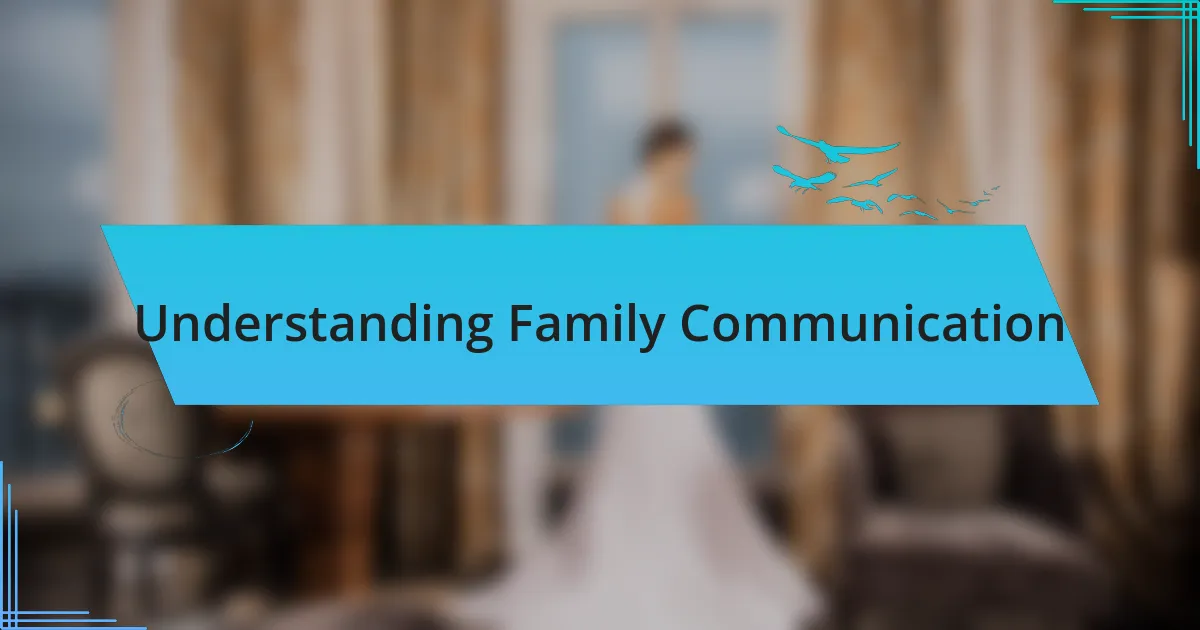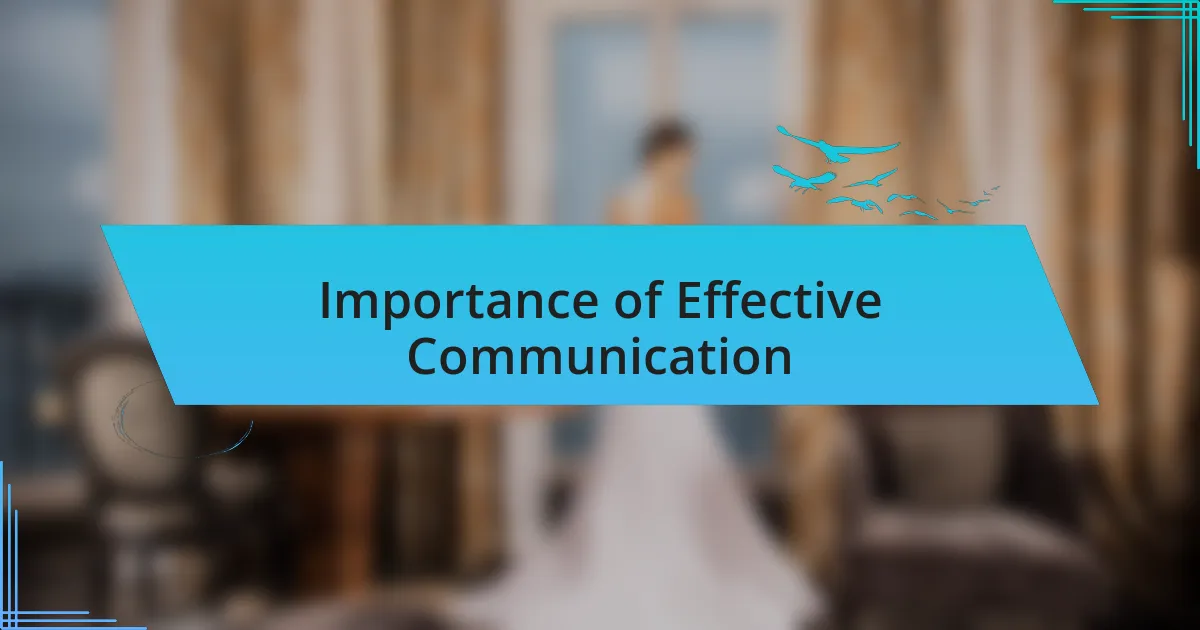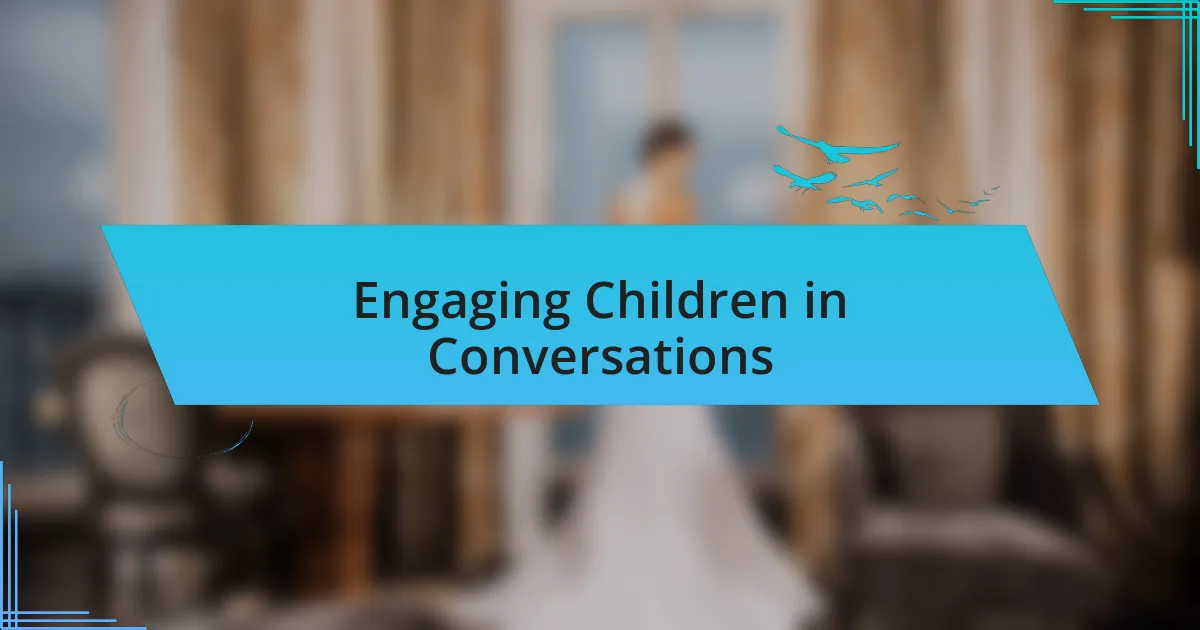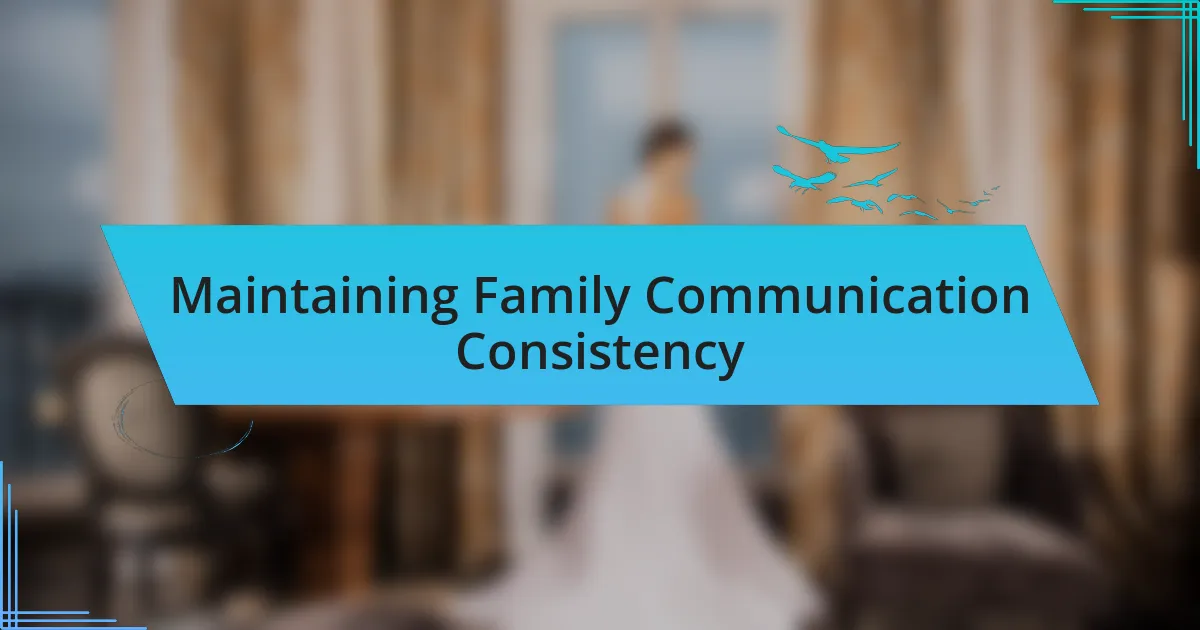Key takeaways:
- Family communication is essential for healthy relationships, emphasizing the importance of open, empathetic dialogue.
- Effectively listening and validating emotions can transform conversations and foster emotional safety within families.
- Intentional practices like regular family meetings and open-ended questions can enhance connections and encourage deeper discussions.
- Engaging children in family conversations and decision-making promotes their involvement and enriches family experiences.

Understanding Family Communication
Family communication is the lifeblood of healthy relationships. I remember a time when my family faced a challenge, and instead of shutting down, we gathered around the dinner table and talked openly. It was in that moment I realized how vital it is to express feelings honestly; it’s what keeps us connected and understanding of one another.
Have you ever felt like your family just doesn’t get you? I’ve been there. There have been discussions with my siblings that spiraled into misunderstandings simply because we didn’t take the time to listen. It’s a powerful reminder that empathy can transform a conversation. When we truly listen, we can bridge gaps that seemed insurmountable.
Understanding family communication means recognizing that it’s not just about talking, but really connecting. I find that asking open-ended questions often leads to deeper conversations. For example, instead of asking “Did you have a good day?”, I might ask, “What was the highlight of your day?” This shift invites others to share more, making our interactions richer and more meaningful.

Importance of Effective Communication
Effective communication is essential for building trust within a family. I remember a summer when we decided to embark on a road trip together. With so many differing opinions on where to go and what to do, it could have easily turned chaotic. But by openly discussing our preferences and being willing to compromise, we not only reached a consensus but also strengthened our bond as a family. It underscored just how powerful clear dialogue can be in creating harmony.
Moreover, effective communication fosters emotional safety, allowing family members to express their thoughts without fear of judgment. I think back to a time when my teenage niece felt comfortable enough to share her struggles with school. Just by being there and actively listening, I could see her anxiety slowly dissipate. Have you ever experienced that moment when someone finally feels heard? It’s transformative, showing that communication is not just about exchanging words but about nurturing a space where everyone feels valued.
In the hustle and bustle of daily life, we often underestimate the significance of frequent check-ins. I’ve found that dedicating just a few minutes each day to touch base with my family makes a world of difference. Whether it’s a simple text or an evening chat, those moments reinforce our connections and remind us that we’re all in this together. This ongoing dialogue turns our family into a support system where everyone feels appreciated and understood.

Challenges in Family Communication
Challenges in family communication often arise from our busy lives and varying schedules. I’ve noticed that when things get hectic, my family slips into a routine where we barely exchange more than a few words each day. How often have you been in a situation where you feel like you’re living under the same roof yet hardly connecting? This disconnect can lead to misunderstandings and frustration, making it crucial to prioritize intentional conversations.
Differing communication styles can also create barriers. I have a cousin who communicates through jokes and light-hearted banter, while I tend to be more straightforward and serious. During family gatherings, I’ve sometimes felt like I’m not truly understood, and it makes me wonder—how can we find common ground when our ways of expressing ourselves are so different? Recognizing these differences is vital, as they can either build walls or bridge gaps in our understanding.
Lastly, emotional baggage from past conflicts can linger and affect how we talk to one another. I recall a disagreement with my sibling that left us both feeling hurt for some time. To this day, the remnants of that conversation come back when we try to discuss sensitive topics. Have you ever carried a feeling from one conversation into another? It’s a challenge that requires ongoing effort and courage to address openly, allowing for healing and renewed connection.

Tips for Better Listening
To truly listen, shifting your mindset is essential. I remember a moment when my daughter was passionately sharing her day at school—a vivid story about her new favorite book. Instead of just waiting for my turn to talk, I forced myself to be fully present, putting down my phone and making eye contact. Have you ever tried this? Focusing solely on the speaker can create a stronger connection and make the other person feel valued.
Emotional validation is another key aspect of effective listening. There was a time when my partner expressed feeling overwhelmed with work, and instead of jumping in with solutions, I simply reflected back what I heard. “It sounds like you’re really stressed out,” I said, and her sigh of relief was immediate. Acknowledging feelings can change the dynamic of the conversation, leading to a more open dialogue. Why does offering understanding sometimes feel harder than giving advice?
Lastly, asking open-ended questions can enhance the listening experience. I recall discussing plans for a family trip, and rather than saying, “Yes, that sounds good,” I asked, “What’s the most exciting part for you?” This approach kept the conversation flowing and showed my genuine interest in their thoughts. Isn’t it amazing how a simple question can make someone feel more engaged and heard? Incorporating this habit into daily conversations can transform the way we connect and communicate as a family.

Strategies for Open Dialogue
Starting an open dialogue within the family can often feel daunting, but it doesn’t have to be. I remember a family dinner where we decided to share one thing we appreciated about each other. As we went around the table, I noticed the smiles and nods of acknowledgment. It was a simple act, yet it created a warm atmosphere that made everyone more willing to share openly. Have you ever thought about how small gestures can open a floodgate of honest conversation?
Another effective strategy is to share personal stories that relate to the topic at hand. For instance, there was a time when I had to navigate a difficult work situation. In sharing my experience, I encouraged my kids to express their feelings about their own school challenges. It felt liberating for them to see that even adults face hurdles, and that allowed us to talk freely about emotions without fear of judgment. Isn’t it enlightening how vulnerability can foster trust and openness?
Lastly, incorporating regular family meetings can be extremely beneficial. We dedicated time every Sunday to sit together and discuss our week—what went well and what didn’t. I vividly remember a time when my son unexpectedly opened up about his struggles with friendships at school. These gatherings have not only improved our communication, but they’ve also strengthened our bond. Have you considered how scheduled time for sharing can create a safe space for discussions?

Engaging Children in Conversations
Engaging children in conversations can be truly rewarding. I recall a rainy afternoon when I decided to play a guessing game with my daughter using everyday objects around the house. As we took turns describing items without naming them, I noticed how her imagination sparked and our laughter filled the room. Isn’t it amazing how playful interactions can turn simple moments into memorable conversations?
One technique that has worked wonders for me is asking open-ended questions. Instead of “Did you have a good day?”, I started to ask, “What was the most exciting thing that happened today?” This small shift in wording opened the door to deeper discussions. My son once shared a hilarious mishap he had in the school playground, which led us to a fascinating conversation about friendship and teamwork. Have you found that the right questions can reveal unexpected insights into your child’s world?
Sometimes, including children in decision-making can foster engagement too. During our family vacation planning, I encouraged my kids to suggest activities they wanted to try. Their eyes lit up with enthusiasm as they proposed everything from building sandcastles to trying local foods. Including them in these conversations not only made them feel valued but also allowed us to connect over shared goals. How often do we realize that involving children can lead to richer conversations and family experiences?

Maintaining Family Communication Consistency
Maintaining consistency in family communication is a challenge I’ve sometimes struggled with, but I’ve learned it’s essential for building trust. For instance, I make it a point to have dinner together every night. This not only provides an opportunity for everyone to share their day but also reinforces the importance of being present and engaged with one another. Have you noticed how routine can create a safe space for conversation?
I also try to check in with my family throughout the week, even with a simple text or call to ask about their day. I remember a time when a quick message to my wife while she was at work sparked a deeper discussion about our plans for the weekend. That small effort made her feel supported and connected, even amidst a busy schedule. How often do you reach out to touch base with your family, just to stay in the loop?
Additionally, I find that setting specific family communication goals helps keep us on track. For example, we decided to allocate Sunday afternoons for family meetings. During these times, we openly discuss any issues or joys, creating a culture of transparency. I’ve found that this approach not only strengthens our bond but also encourages everyone to articulate their thoughts and feelings. Isn’t it fascinating how a little structure can enhance the fluidity of family conversations?